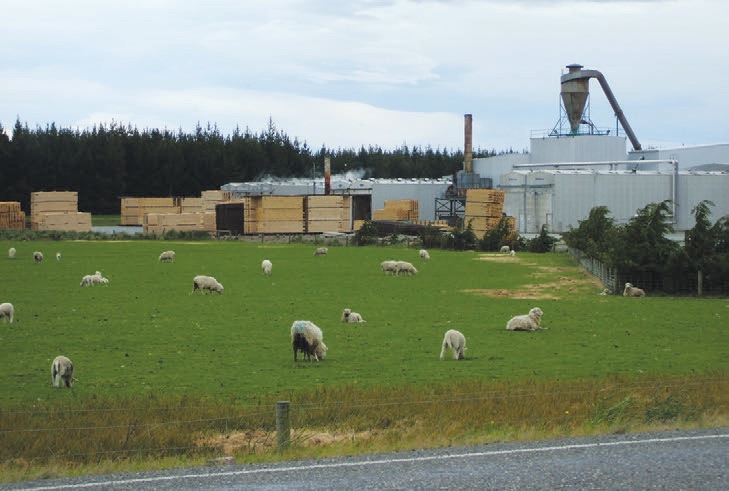Processing the Southland timber resource
Parnell Trost, New Zealand Tree Grower February 2009.
Southland has a well established timber processing industry, with several of the leading mills operating for more than 70 years. The timber industry has been one of the reasons for the success of the Southland economy over the past two decades, with strong growth in sawmilling capacity and investment in a range of downstream processing activities. This investment has moved the industry from being primarily a domestic supplier of timber with some export activity, to one of Southland’s major export industries.
A key development in the growth of the processing industry was the establishment of a medium density fibreboard factory in 1997. The Dongwha Patinna plant handles a significant proportion of the region’s lower grade logs, along with wood residues. This development was followed in 1998 with a rotary veneer operation at Kennington, north of Invercargill.
Export market
The majority of the new investment in timber processing has been undertaken with the export market in mind. The region’s two largest mills have been exporting between 80 and 85 per cent of their annual production, principally to East Asia, Australia and the United States. A significant proportion of these exports is used in the re-manufacturing and furniture industries.
The region’s second tier mills are more focused on the domestic market but a number have considered export opportunities. The region has eight mills with an annual production of sawn timber of between 500 and 20,000 cubic metres, and three mills in the 20,000 to 120,000 cubic metre range. In addition to this, there are a number of portable operations servicing their immediate communities.

The Southland region has New Zealand’s largest processor of sustainably harvested indigenous timber. The Lindsay & Dixon mill at Tuatapere, processes silver beech and small quantities of other native species for flooring, furniture, joinery and panelling.
The region’s veneer, MDF and chip manufacturers also have a strong focus on the export market. Dongwha Patinna has built- up markets for their range of MDF products in China, Japan and the United States, while Southland Veneers Ltd supplies veneers to customers in the Philippines, Malaysia, South Korea and Japan. Another important exporter is South Wood Export Limited, which operates a wood chipping facility near Bluff, and processes the region’s maturing eucalypt estate for pulp and paper manufacturing in Japan.
Log supplies
One of the attractions for processors in locating in Southland has been the ability to draw on log supplies from both Southland and South Otago. The South Otago forests exceed 80,000 hectares and are located within 100 to 150 kilometres of Invercargill. A well developed roading network means that it is economic for south Otago and even mid Otago logs to be transported to the major mills and processing facilities in Southland.
The integrated nature of the Otago Southland roading network is also an advantage when it comes to exporting timber products. Southland processors are able to use the shipping services through both Bluff and Port Chalmers. This provides processors with a larger number of scheduled shipping services, and helps to reduce the logistical chain to customers.
The investment over the past two decades in additional processing has brought some tangible benefits to growers which include −
- Strong competition for logs
- Processing options for all log grades rather than having to downgrade logs
- Improvements in timber conversion rates with economies of scale and modernisation
- Less dependence upon a single market or product grade in the event of a downturn.
Current and future trends
While the industry has faced a challenging operating environment over the past five years, initiatives are still continuing to raise productivity and to increase the recoverable volume of timber from each log. These include energy audits, the increased use of scanning technology to improve recovery rates, the introduction of new equipment to cut smaller diameter logs and moves to more fully automate the milling and grading process. These measures provide incremental gains in productivity, and are important for ensuring the continued competitiveness of local mills.
Creating additional value from Southland’s forests is also being achieved by tailoring production to market demands. Dongwha Patinna has developed a range of MDF products including a line of MDF sourced from Forest Stewardship Council (FSC) certified plantations. Another initiative has been to differentiate the radiata pine grown in Otago and Southland by focusing upon its distinctive characteristics such as lighter colouring and longer inter-nodal lengths.
The industry is also looking at the opportunities to use more harvest residues for bio-energy and in the longer term bio-fuel. The Southland processing industry already uses a high proportion of mill residues for heat production,and trials have been undertaken on the logistics of transporting residues from harvest sites to energy plants.
The next 12 to 18 months is likely to be a difficult time for all timber processing companies in New Zealand, not just those in Southland, with the deterioration in market conditions and customers facing difficulties in securing access to credit. Longer term, however,the growing timber supply in Otago and Southland provides a strong basis for further investment in timber processing.

 Farm Forestry New Zealand
Farm Forestry New Zealand